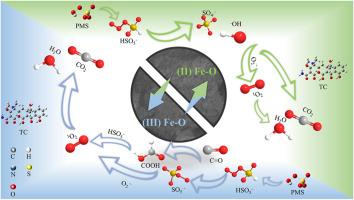通过水热处理和低温空气煅烧制备掺杂铁的生物炭,激活过硫酸盐以高效降解四环素
IF 8.7
Q1 Environmental Science
引用次数: 0
摘要
本研究通过水热处理和低温空气煅烧两步法制备了一种新型污泥基生物炭(Fe/SSBC),并通过活化过一硫酸盐(PMS)来降解四环素(TC)。经过 30 分钟反应后,优化的 Fe/SSBC/PMS 系统对 TC(50 mg/L)的去除率超过 98%(k = 0.166 min-1),是单独水热处理(k = 0.076 min-1)的 2.18 倍。此外,它还表现出良好的稳定性。详细表征显示了水热处理对生物炭表面 Fe-O 配位的影响,以及空气煅烧对 Fe 价态的改变。电子顺磁共振(EPR)、电化学分析和淬灭实验证实单线态氧(1O2)是主要的活性物质。我们通过 DFT 计算进一步阐明了接枝 Fe-O 对生物炭表面电子分布的影响。此外,还根据 LC-MS 分析提出了两种可能的途径。本研究提出了一种在低能耗条件下制备高催化性能污泥基碳材料的方法,为污泥循环利用提供了一种新策略。本文章由计算机程序翻译,如有差异,请以英文原文为准。

Fe-doped biochars prepared via hydrothermal treatment and low-temperature air calcination to activate peroxymonosulfate for efficient tetracycline degradation
In this study, a new sludge-based biochar loaded with Fe species (Fe/SSBC) was prepared by a two-step process involving hydrothermal treatment and low-temperature air calcination, and used to degrade tetracycline (TC) by activating peroxymonosulfate (PMS). After 30 min reaction, more than 98 % TC (50 mg/L) could be removed by optimized Fe/SSBC/PMS system (k = 0.166 min−1), which was 2.18 times compared with individual hydrothermal treatment (k = 0.076 min−1). Besides, it also exhibited good stabilization. Detailed characterizations revealed the effect of hydrothermal treatment on the Fe–O coordination of the biochar surface and the change of the Fe valence state by air calcination. The electron paramagnetic resonance (EPR), electrochemical analysis and quenching experiments confirmed that singlet oxygen (1O2) was the main active substance. We further elucidated the influence of grafting Fe–O on the surface electron distribution of biochar by DFT calculations. Moreover, two possible pathways were proposed based on LC-MS analysis. In this study, a method of preparing high catalytic performance sludge-based carbon materials under low energy consumption has been proposed, which provides a new strategy for sludge recycling.
求助全文
通过发布文献求助,成功后即可免费获取论文全文。
去求助
来源期刊

Water Cycle
Engineering-Engineering (miscellaneous)
CiteScore
9.20
自引率
0.00%
发文量
20
审稿时长
45 days
 求助内容:
求助内容: 应助结果提醒方式:
应助结果提醒方式:


